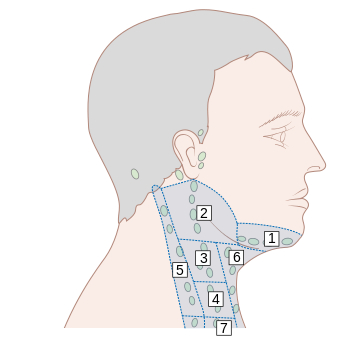History and exam
Key diagnostic factors
common
presence of risk factors
Epstein-Barr virus infection is the main risk factor for nasopharyngeal cancer (NPC). Other risk factors include a diet rich in preserved food (in particular salted fish), smoking or other tobacco use, and having a first-degree relative with a history of NPC.
neck mass
Most common presentation of nasopharyngeal cancer (NPC) (76%).[4]
Among people with NPC who present with neck masses, lymphadenopathy in level II is the most common location, which is similar to other head and neck mucosal squamous cell carcinomas.[5][6] However, level V lymphadenopathy in the posterior cervical triangle is relatively common in NPC, and this pattern of lymph node spread distinguishes NPC from many other head and neck cancers.
[Figure caption and citation for the preceding image starts]: Lymph node groups in the head and neck; the numbers refer to the anatomical levels of the lymph nodesCancer Research UK [Citation ends].
epistaxis or bloody nasal discharge
Nasal symptoms are common in people presenting with nasopharyngeal cancer (NPC) (73%) and should raise suspicion of NPC in an Asian patient.[4]
nasal obstruction
Nasal symptoms are common in people presenting with nasopharyngeal cancer (NPC) (73%) and should raise suspicion of NPC in an Asian patient.[4]
tinnitus or impaired hearing
Aural symptoms are common in people presenting with nasopharyngeal cancer (NPC) (62%) and should raise suspicion of NPC in an Asian patient.[4]
unilateral otitis media with effusion
Common but not specific to nasopharyngeal cancer.
uncommon
cranial nerve palsy
All 12 cranial nerves could be involved but the involvement of cranial nerves V and VI is most common.[24]
Other diagnostic factors
common
headaches
Occur in 35% of people presenting with nasopharyngeal cancer.[4] Suggests cranial nerve involvement.
uncommon
diplopia or strabismus
Occurs in 11% of people with nasopharyngeal cancer.[4] Suggests involvement of cranial nerves III, IV, or V.
facial numbness
Occurs in 8% of people with nasopharyngeal cancer.[4] Suggests cranial nerve V involvement (trigeminal).
fever
May indicate a malignancy generally, though not specific to nasopharyngeal cancer.
night sweats
May indicate a malignancy generally, though not specific to nasopharyngeal cancer.
unintentional weight loss
May indicate a malignancy generally, though not specific to nasopharyngeal cancer.
Risk factors
strong
Epstein-Barr virus (EBV) infection
Most important risk factor for nasopharyngeal cancer (NPC). EBV DNA and EBV-latent proteins can be detected in NPC precursor lesions and tumour cells. Polymerase chain reaction (PCR) can detect circulating EBV DNA in the plasma in >95% of people with NPC.[10]
weak
diet high in salted fish
The mechanism for how salted fish consumption causes nasopharyngeal cancer is not established but is thought to be due to exposure to nitrosamines and/or reactivation of latent EBV infection.[11] Case-control studies have since been published in Hong Kong and mainland China.[15] One case-control study on Alaska natives also reported a positive association with salted fish consumption in childhood.[16]
first-degree relative with nasopharyngeal cancer (NPC)
A family history of NPC in a first-degree relative is associated with a relative risk of developing NPC of 6-21, compared with healthy controls based on several cohort studies.[12]
smoking
Investigating smoking as a risk factor for nasopharyngeal cancer, one meta-analysis from 2013 reported a pooled odds ratio of 1.60 (95% CI 1.38 to 1.87) from 32 studies.[13] Another meta-analysis reported a pooled odds ratio of 1.56 (95% CI 1.32 to 1.83) from 19 studies. The studies included in both meta-analyses had substantial heterogeneity.[14]
human papilloma virus (HPV) infection
One retrospective study of 1328 patients in southern China found that 102 (7.7%) patients had HPV-positive tumours.[17]
Use of this content is subject to our disclaimer